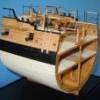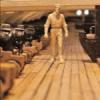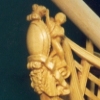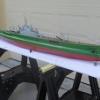
Roger Pellett
-
Posts
4,519 -
Joined
-
Last visited
Reputation Activity
-
 Roger Pellett got a reaction from dvm27 in Steamboats and other rivercraft - general discussion
Roger Pellett got a reaction from dvm27 in Steamboats and other rivercraft - general discussion
A number of years ago the late model builder William F. Wiseman built a model of the very small river boat Myrtle Corey. He built the model entirely from photographs using geometric projection techniques. The NRG has downloadable copies describing his techniques that can be bought for a few dollars. Look up his name on their website. Mystic Seaport bought his model collection from his estate and those of us that attended last fall's NRG conference got to see them. The photo's in the Journal do not do them justice. I remember seeing his spectacular Far West model but not Myrtle Corey.
Roger Pellett
-
 Roger Pellett got a reaction from Canute in what wood to use for specifics....
Roger Pellett got a reaction from Canute in what wood to use for specifics....
If you are buying power tools and are buying unseasoned lumber you might find a small jointer more useful. A surface planer does not easily handle twisted lumber. It works best if you can put a flat surface down against the platen and the cutter head then planes the other surface parallel. If you try to plane a board with two irregular surfaces the pressure from the cutter head twists the board.
By planing one side flat or better yet two sides flat and square with a jointer you can then square the board's remaining sides with a table saw or band saw. You can then rip uniform slices with a table or band saw. If you still want a planer, the jointer is needed to first flatten one surface.
I have a 3in Rockwell jointer that I bought many years ago. This is a heavy all cast iron tool that is large enough to handle ship modeling wood. I would rather use it than the cheaply made handy man quality tools sold by the big box retailers today. I suspect that you can find an inexpensive one used.
Roger Pellett
-
 Roger Pellett got a reaction from EJ_L in what wood to use for specifics....
Roger Pellett got a reaction from EJ_L in what wood to use for specifics....
If you are buying power tools and are buying unseasoned lumber you might find a small jointer more useful. A surface planer does not easily handle twisted lumber. It works best if you can put a flat surface down against the platen and the cutter head then planes the other surface parallel. If you try to plane a board with two irregular surfaces the pressure from the cutter head twists the board.
By planing one side flat or better yet two sides flat and square with a jointer you can then square the board's remaining sides with a table saw or band saw. You can then rip uniform slices with a table or band saw. If you still want a planer, the jointer is needed to first flatten one surface.
I have a 3in Rockwell jointer that I bought many years ago. This is a heavy all cast iron tool that is large enough to handle ship modeling wood. I would rather use it than the cheaply made handy man quality tools sold by the big box retailers today. I suspect that you can find an inexpensive one used.
Roger Pellett
-
 Roger Pellett got a reaction from mtaylor in what wood to use for specifics....
Roger Pellett got a reaction from mtaylor in what wood to use for specifics....
If you are buying power tools and are buying unseasoned lumber you might find a small jointer more useful. A surface planer does not easily handle twisted lumber. It works best if you can put a flat surface down against the platen and the cutter head then planes the other surface parallel. If you try to plane a board with two irregular surfaces the pressure from the cutter head twists the board.
By planing one side flat or better yet two sides flat and square with a jointer you can then square the board's remaining sides with a table saw or band saw. You can then rip uniform slices with a table or band saw. If you still want a planer, the jointer is needed to first flatten one surface.
I have a 3in Rockwell jointer that I bought many years ago. This is a heavy all cast iron tool that is large enough to handle ship modeling wood. I would rather use it than the cheaply made handy man quality tools sold by the big box retailers today. I suspect that you can find an inexpensive one used.
Roger Pellett
-
 Roger Pellett got a reaction from Gerhardvienna in Steamboats and other rivercraft - general discussion
Roger Pellett got a reaction from Gerhardvienna in Steamboats and other rivercraft - general discussion
A number of years ago the late model builder William F. Wiseman built a model of the very small river boat Myrtle Corey. He built the model entirely from photographs using geometric projection techniques. The NRG has downloadable copies describing his techniques that can be bought for a few dollars. Look up his name on their website. Mystic Seaport bought his model collection from his estate and those of us that attended last fall's NRG conference got to see them. The photo's in the Journal do not do them justice. I remember seeing his spectacular Far West model but not Myrtle Corey.
Roger Pellett
-
 Roger Pellett got a reaction from Canute in Steamboats and other rivercraft - general discussion
Roger Pellett got a reaction from Canute in Steamboats and other rivercraft - general discussion
A number of years ago the late model builder William F. Wiseman built a model of the very small river boat Myrtle Corey. He built the model entirely from photographs using geometric projection techniques. The NRG has downloadable copies describing his techniques that can be bought for a few dollars. Look up his name on their website. Mystic Seaport bought his model collection from his estate and those of us that attended last fall's NRG conference got to see them. The photo's in the Journal do not do them justice. I remember seeing his spectacular Far West model but not Myrtle Corey.
Roger Pellett
-
 Roger Pellett got a reaction from mtaylor in Applying fiberglass Resin/epoxy
Roger Pellett got a reaction from mtaylor in Applying fiberglass Resin/epoxy
I just noticed an error in my post.
The second sentence of the last paragraph should read, "Work the mix into the cloth with a plastic squeegee.
Also, make sure that the resin and hardener are well mixed. The system that I use says to mix for a full minute. Another good reason for using a quality marine epoxy system is that some of the better brands have great free customer support information.
Roger Pellett
-
 Roger Pellett got a reaction from GuntherMT in Applying fiberglass Resin/epoxy
Roger Pellett got a reaction from GuntherMT in Applying fiberglass Resin/epoxy
I have some experience working with fiberglass on full sized boats and I mostly made a mess of things until I learned a few simple tricks.
First, use a high quality resin/ hardener system, not the stuff from the auto dept of the local big box store. There are a number of high quality boat building resins, all expensive but when you consider the cost and time spent on the kit, a resin that doesn't cure properly is bad news.
More hardener is not better! You must mix in the proper proportions. Too much or too little hardener and you will wind up with a sticky mess. Select a quality resin/ hardener system that comes with a reliable way of metering resin and hardeneR. For the system that I use, calibrated mini pumps are available that screw into the top of the resin and hardener cans. By alternating squirts of hardener and resin, you can't go wrong.
Use glass cloth matched to the application. Fiberglass cloth is cheap, so make sure that you are using nice thin material, not something intended to patch a car fender.
Drape the cloth over the hull dry, and then apply the resin hardener mix Work the hardener into the cloth until the weave disappears. Don't put the resin on first and try to "glue" the cloth to it. Believe me, I tried it and wound ep with air trapped under the cloth and bubbles that were impossible to squeege out. Once I learned this trick by accident, I had no trouble working with fiberglass.
Roger Pellett
-
 Roger Pellett got a reaction from mtaylor in Applying fiberglass Resin/epoxy
Roger Pellett got a reaction from mtaylor in Applying fiberglass Resin/epoxy
I have some experience working with fiberglass on full sized boats and I mostly made a mess of things until I learned a few simple tricks.
First, use a high quality resin/ hardener system, not the stuff from the auto dept of the local big box store. There are a number of high quality boat building resins, all expensive but when you consider the cost and time spent on the kit, a resin that doesn't cure properly is bad news.
More hardener is not better! You must mix in the proper proportions. Too much or too little hardener and you will wind up with a sticky mess. Select a quality resin/ hardener system that comes with a reliable way of metering resin and hardeneR. For the system that I use, calibrated mini pumps are available that screw into the top of the resin and hardener cans. By alternating squirts of hardener and resin, you can't go wrong.
Use glass cloth matched to the application. Fiberglass cloth is cheap, so make sure that you are using nice thin material, not something intended to patch a car fender.
Drape the cloth over the hull dry, and then apply the resin hardener mix Work the hardener into the cloth until the weave disappears. Don't put the resin on first and try to "glue" the cloth to it. Believe me, I tried it and wound ep with air trapped under the cloth and bubbles that were impossible to squeege out. Once I learned this trick by accident, I had no trouble working with fiberglass.
Roger Pellett
-
 Roger Pellett got a reaction from dafi in up and down anchor lifting
Roger Pellett got a reaction from dafi in up and down anchor lifting
With regard to dafi's post above two opposite forces act on a submerged object. Gravity equal to the open air weight of the object is pulling it down. Buoyancy equal to the weight of the the water displaced by the object is pushing up. The force on the anchor cable is therefore equal to the net of these two forces.
If water is one seventh as dense as wrought iron, then the force on the anchor cable after being broken out is 6/7 not 1/7 of the anchor's weight.
Roger Pellett
-
 Roger Pellett got a reaction from wefalck in up and down anchor lifting
Roger Pellett got a reaction from wefalck in up and down anchor lifting
With regard to dafi's post above two opposite forces act on a submerged object. Gravity equal to the open air weight of the object is pulling it down. Buoyancy equal to the weight of the the water displaced by the object is pushing up. The force on the anchor cable is therefore equal to the net of these two forces.
If water is one seventh as dense as wrought iron, then the force on the anchor cable after being broken out is 6/7 not 1/7 of the anchor's weight.
Roger Pellett
-
 Roger Pellett got a reaction from popeye2sea in up and down anchor lifting
Roger Pellett got a reaction from popeye2sea in up and down anchor lifting
With regard to dafi's post above two opposite forces act on a submerged object. Gravity equal to the open air weight of the object is pulling it down. Buoyancy equal to the weight of the the water displaced by the object is pushing up. The force on the anchor cable is therefore equal to the net of these two forces.
If water is one seventh as dense as wrought iron, then the force on the anchor cable after being broken out is 6/7 not 1/7 of the anchor's weight.
Roger Pellett
-
 Roger Pellett got a reaction from jud in up and down anchor lifting
Roger Pellett got a reaction from jud in up and down anchor lifting
With regard to dafi's post above two opposite forces act on a submerged object. Gravity equal to the open air weight of the object is pulling it down. Buoyancy equal to the weight of the the water displaced by the object is pushing up. The force on the anchor cable is therefore equal to the net of these two forces.
If water is one seventh as dense as wrought iron, then the force on the anchor cable after being broken out is 6/7 not 1/7 of the anchor's weight.
Roger Pellett
-
 Roger Pellett got a reaction from dashi in up and down anchor lifting
Roger Pellett got a reaction from dashi in up and down anchor lifting
With regard to dafi's post above two opposite forces act on a submerged object. Gravity equal to the open air weight of the object is pulling it down. Buoyancy equal to the weight of the the water displaced by the object is pushing up. The force on the anchor cable is therefore equal to the net of these two forces.
If water is one seventh as dense as wrought iron, then the force on the anchor cable after being broken out is 6/7 not 1/7 of the anchor's weight.
Roger Pellett
-
 Roger Pellett got a reaction from rybakov in up and down anchor lifting
Roger Pellett got a reaction from rybakov in up and down anchor lifting
With regard to dafi's post above two opposite forces act on a submerged object. Gravity equal to the open air weight of the object is pulling it down. Buoyancy equal to the weight of the the water displaced by the object is pushing up. The force on the anchor cable is therefore equal to the net of these two forces.
If water is one seventh as dense as wrought iron, then the force on the anchor cable after being broken out is 6/7 not 1/7 of the anchor's weight.
Roger Pellett
-
 Roger Pellett got a reaction from trippwj in up and down anchor lifting
Roger Pellett got a reaction from trippwj in up and down anchor lifting
With regard to dafi's post above two opposite forces act on a submerged object. Gravity equal to the open air weight of the object is pulling it down. Buoyancy equal to the weight of the the water displaced by the object is pushing up. The force on the anchor cable is therefore equal to the net of these two forces.
If water is one seventh as dense as wrought iron, then the force on the anchor cable after being broken out is 6/7 not 1/7 of the anchor's weight.
Roger Pellett
-
 Roger Pellett got a reaction from Canute in Some criteria for starting a new group project
Roger Pellett got a reaction from Canute in Some criteria for starting a new group project
If the intent of this or any group project is to introduce model builders to scratch building, the Hahn system has much to recommend. The idea of a flat jig/datum to lock frames in place goes a long way towards ensuring an accurate hull. For builders with limited workshop capacity, strip milled to the correct dimensions can be purchased, cut with a minirature miter box and laminated and cut to shape using simple hand tools. Many years ago, I built a model of the New York pilot boat Express using the Hahn system and over 30 years later am still quite proud of it. While building a model "upright" using individual timbers may better represent actual shipbuilding practice, I would argue that a builder wishing to include this level of detail, and capable of executing it does not need to and might not be interested in a group build.
Roger Pellett
-
 Roger Pellett got a reaction from mtaylor in Some criteria for starting a new group project
Roger Pellett got a reaction from mtaylor in Some criteria for starting a new group project
If the intent of this or any group project is to introduce model builders to scratch building, the Hahn system has much to recommend. The idea of a flat jig/datum to lock frames in place goes a long way towards ensuring an accurate hull. For builders with limited workshop capacity, strip milled to the correct dimensions can be purchased, cut with a minirature miter box and laminated and cut to shape using simple hand tools. Many years ago, I built a model of the New York pilot boat Express using the Hahn system and over 30 years later am still quite proud of it. While building a model "upright" using individual timbers may better represent actual shipbuilding practice, I would argue that a builder wishing to include this level of detail, and capable of executing it does not need to and might not be interested in a group build.
Roger Pellett
-
 Roger Pellett reacted to Capt.Bob in Young America 1853 by EdT - FINISHED - extreme clipper
Roger Pellett reacted to Capt.Bob in Young America 1853 by EdT - FINISHED - extreme clipper
Concerning the application of CA in very small quantities, I use the ink pen from an old drafting set. For those of you who aren't old enough to remember, imagine making ink drawing by hand. I have some drawings that my grandfather made in 1898 while in tech school. The ink pen is infinitely adjustable and allows you to control the gap and provide extremely small applications of either thin or medium CA. It doesn't work very well for thick CA.
Roger, they do make a vapor free CA that eliminates the nose/throat problem. It acts more slowly and avoids the flash cure and associated vapors.
Bob
-
 Roger Pellett got a reaction from EdT in Young America 1853 by EdT - FINISHED - extreme clipper
Roger Pellett got a reaction from EdT in Young America 1853 by EdT - FINISHED - extreme clipper
In my opinion, CA can be nasty stuff. Several years ago, I ised it to glue ribs into some small boats that I had vacuum formed from plastic. This caused exposure to a fair quantity of glue over a period of an hour or so. I was also careless in handling the stuff. The glue did a great job of gluing in the ribs but gave me a serious nasal congestion and sore throat. Now I avoid it whenever possible and am careful to only squeeze out a drop or two at a time into a plastic container lid.
Roger Pellett
-
 Roger Pellett got a reaction from Piet in Young America 1853 by EdT - FINISHED - extreme clipper
Roger Pellett got a reaction from Piet in Young America 1853 by EdT - FINISHED - extreme clipper
In my opinion, CA can be nasty stuff. Several years ago, I ised it to glue ribs into some small boats that I had vacuum formed from plastic. This caused exposure to a fair quantity of glue over a period of an hour or so. I was also careless in handling the stuff. The glue did a great job of gluing in the ribs but gave me a serious nasal congestion and sore throat. Now I avoid it whenever possible and am careful to only squeeze out a drop or two at a time into a plastic container lid.
Roger Pellett
-
 Roger Pellett got a reaction from mtaylor in Young America 1853 by EdT - FINISHED - extreme clipper
Roger Pellett got a reaction from mtaylor in Young America 1853 by EdT - FINISHED - extreme clipper
In my opinion, CA can be nasty stuff. Several years ago, I ised it to glue ribs into some small boats that I had vacuum formed from plastic. This caused exposure to a fair quantity of glue over a period of an hour or so. I was also careless in handling the stuff. The glue did a great job of gluing in the ribs but gave me a serious nasal congestion and sore throat. Now I avoid it whenever possible and am careful to only squeeze out a drop or two at a time into a plastic container lid.
Roger Pellett
-
 Roger Pellett got a reaction from slow2cool in Young America 1853 by EdT - FINISHED - extreme clipper
Roger Pellett got a reaction from slow2cool in Young America 1853 by EdT - FINISHED - extreme clipper
In my opinion, CA can be nasty stuff. Several years ago, I ised it to glue ribs into some small boats that I had vacuum formed from plastic. This caused exposure to a fair quantity of glue over a period of an hour or so. I was also careless in handling the stuff. The glue did a great job of gluing in the ribs but gave me a serious nasal congestion and sore throat. Now I avoid it whenever possible and am careful to only squeeze out a drop or two at a time into a plastic container lid.
Roger Pellett
-
 Roger Pellett reacted to captainbob in 131 year old iron hulled ship Wavertree being restored
Roger Pellett reacted to captainbob in 131 year old iron hulled ship Wavertree being restored
In the 131 years since the iron-hulled cargo ship Wavertree was built, it has been tossed and tattered — its main mast ripped away in a hurricane, and its role demoted to sand barge. Now it’s being restored. Read about it here.
Bob
-
 Roger Pellett got a reaction from coxswain in Sail design for 18th-century longboat?
Roger Pellett got a reaction from coxswain in Sail design for 18th-century longboat?
More important than the topping lift, the peak halyard now is more in line with the leach to help prevent it from sagging to leeward. I do not believe that the tack of the main sheet was belayed to the inner end of the boom. The boom's gooseneck on the drawing that I am using is a reader flimsy hook that would not withstand an upward force. The throat halyard pulling on the luff of the sail would pull the boom out of the fitting. On models that I have seen made from your kit, this fitting is similar. Rather I believe that the tack belayed further down the mast or to a ring bolt attached to the boat's keelson. The boom is then in compression acting as a pole to spread the sail's foot.
The dimension of the foot of the staysail Is set by the distance between the fore stay and the mast. Unfortunately, I am traveling so don't have access to my library to comment on other dimensions. I will look over my drawing when I return. The staysail should be hanked to the stay all along so the luff is supported by the stay.. The tack would be hooked to the stem head.
If you agree with my premise that the jib was intended for off the wind sailing, a single part halyard probably would be sufficient as there would be no need to be able to maintain a tight luff. Sheets could be belayed or snubbed to any convenient point within the boat.
Considering that it was necessary to rig the boat often I would suggest erring on the side of less is better and not providing down hauls for either of the headsails. The jib would normally be hauled in to the stem head using the traveler. Otherwise there would be a danger of the boat sailing over the dropped sail.
I believe that you're on the right track.
Roger
















